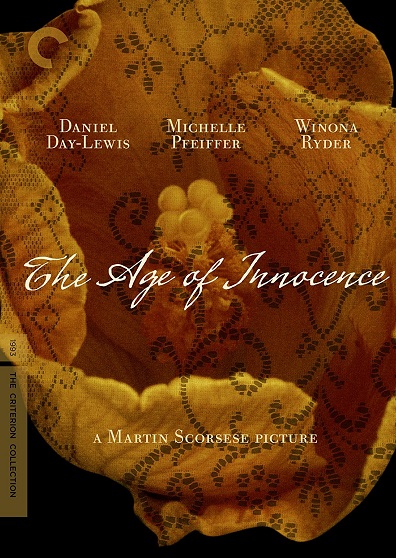
The Age of Innocence
Studio: Criterion
Apr 30, 2018
Web Exclusive
![]()
The way to make flowers, or anything, really, more erotic is a little repression. Repression is a little bit dangerous and sad, because locked behind those bars is full bodied life. That seems to be the unspoken core of Martin Scorsese’s film adaptation of The Age of Innocence, based on the novel by Edith Wharton. The film blooms to life like a Georgia O’Keefe in a harness, with Saul and Elaine Bass’s exquisite opening title sequence of flowers unfolding, with lace superimposed onto their petals. Speaking about this, Scorsese noted, “Quite honestly, I’d never seen anything like it. I was stunned, because the whole movie was there. I said, ‘This is better than the picture!’ They achieve a certain beauty that I had hoped for, and also a certain unease. There is a slightly sinister quality to the underlying impact of the opening credits, a sense of conflict right from the beginning. It has the essence of the film — the longing, the hidden passion. The audience sees a flower, some lace, and some scripts, yet it feels like something is going to happen — and that’s very delicate.”
More than 25 years into his career, Scorsese had made his mark as a director that few would be inclined to call “delicate”, exactly. His work was punctuated with drunks, creeps, martyrs, and the battered and bruised, and the occasional God complex. With the exception of a film here and there, like Alice Doesn’t Live Here Anymore and Boxcar Bertha, Scorsese’s films were, and continue to be, dominated by men; not merely that, but men for whom brutishness and a kind of cruelty is just what they’ve come to understand is a common language.
Other than After Hours, The Age of Innocence comes as somewhat of a surprise: a film in which the ability to express one’s desires and to articulate what exactly machismo means within a given social context—Wharton’s novel spans across the Gilded Age of New York—is on brand for Scorsese, but its delicacy feel fresh and unfamiliar. This is not to say that the film does not fit within Scorsese’s oeuvre; on the contrary, the film is still fundamentally about masculinity. But what makes The Age of Innocence fresh and, beautiful, even is that the story is leant a kind of subjectivity by the unnamed female narrator, played by Joanne Woodward, whose voice is so decadent it’s like dark chocolate.
Lawyer Newland Archer (Daniel Day-Lewis) is thrilled to announce his engagement to May Welland (Winona Ryder) to New York’s high society, but begins to fall for her cousin, Ellen Olenska (Michelle Pfeiffer), who is being followed by scandal wherever she goes, not necessarily of her own accord. These characters, by the very nature of their social class and upbringing, do not say what they mean, and must constantly talk around their feelings and ideas. They wear layers and layers of velvet and lace, covering up any inkling of authenticity, their social performances bred so deeply in them that when Newland is confronted with his feelings for Ellen, and his ever growing complicated feelings for the society at large, watching it feels like watching ink bleed through lace.
There’s a delightful and sad gossipy quality to the film, where Woodwards narrator confides into the audience like a master tale-teller, allowing anecdote and context to fill out the world as Scorsese’s camera and Michael Ballhaus’s cinematography to swing around filling such an arch landscape with verve. If Woodward’s older narrator is indeed telling this story over a period of time, she imbues Newland with a prickly empathy and progressive perspective: No, he does not think Countess Olenska should slink around ashamed; her divorce shouldn’t make her a social outcast.
They all kind of lived in a hieroglyphic world: the real thing was never said or done, but was only represented by a set of arbitrary signs,” Woodward narrates early in the film, as delicately drawn words in cursive flash across the screen, alluding to the way in which people declined a party invitation because of the nonsense “scandal”. If Scorsese had made his career with a kind of gendered action defined by violence, that The Age of Innocence is predicated on characters and their coded language reveals Scorsese’s more versatile in his exploration of masculine expression.
The Age of Innocence is so gloriously detailed with garments, jewelry, silverware, food, flowers, and candles; all an articulation of a kind of desire, erotic and otherwise. Daniel Day-Lewis and Michelle Pfeiffer have never been sexier than when they’ve been unable to say exactly how much they want each other.
www.criterion.com/films/28834-the-age-of-innocence
Current Issue

Issue #72
Apr 19, 2024 Issue #72 - The ‘90s Issue with The Cardigans and Thurston Moore
Most Recent
- Hovvdy (Review) — Hovvdy
- Descendents, Circle Jerks @ Brooklyn Paramount, NYC, April 13, 2024 (Review) — Descendents, Circle Jerks
- Bat For Lashes Shares a Cover of Baauer’s “Home” From Her New Album (News) — Bat For Lashes, Baauer
- Premiere: Veronica Lewis Shares New Single “Disconnected” (News) — Veronica Lewis
- The Decemberists Share New Song “All I Want Is You” (News) — The Decemberists

Comments
Submit your comment
There are no comments for this entry yet.